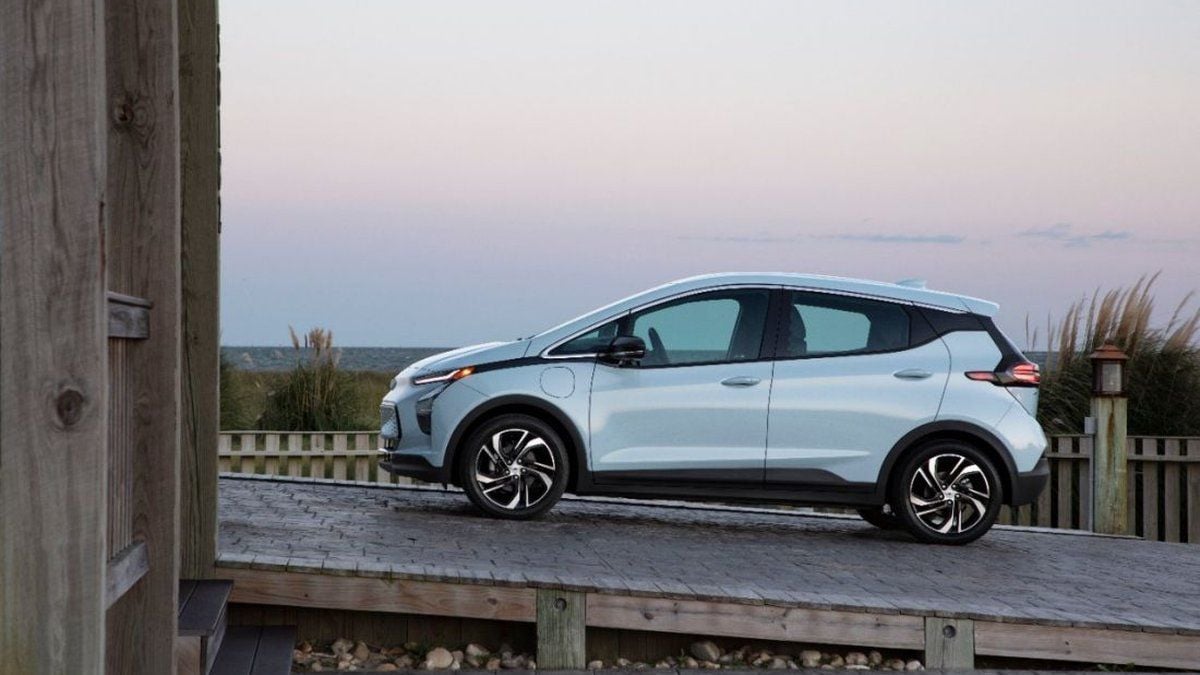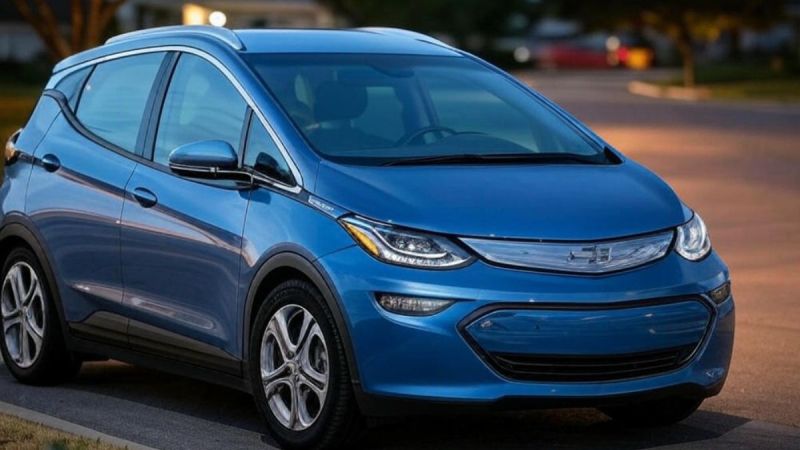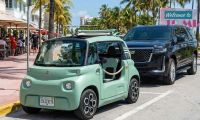When people imagine owning an electric car, they picture a wall-mounted charger in a perfectly lit garage and the peace of mind that comes from being able to “top up” in a couple of hours. That’s the dream, right?
But what if I told you that you don’t need any of that?
This evening, I was doing what I usually do, browsing the “Chevy Bolt EV and EUV Owners” Facebook group, and I came across a post that stopped me in my tracks. It was from Lamar Curtis, who shared how he’s been charging his 2017 Chevy Bolt Premier using nothing but a basic 15-amp garage outlet. No upgrades, no electrician, no NEMA plug. Just the car, the wall, and a smart plug to monitor everything. And it worked perfectly for his family’s driving needs.
Here’s what Lamar wrote: “LEVEL 1 CHARGING TEST RESULTS: I bought a 2017 Chevy Bolt Premier in January 2025. I only have Level 1 charging in my garage. It's on a dedicated 15-amp breaker with nothing else plugged in, so I set the Bolt to charge at 12 amps. I plugged in a smart plug with energy monitoring to track the usage. February we were plugging in every day, and the monthly total was 294 kWh at 12 cents/kWh for a total of $35.33. I also tested Level 2 charging at four ChargePoint locations, and one Tesla Supercharger to test the Lectron adapter. Those totaled $15. For March, I wanted to see what the difference would be if we didn't plug it in every day, and actually went a week without charging at all and still had 31% left after traveling 92 miles during that week. My wife definitely used the heater and didn't care about efficiency during that week. March was 171 kWh at 12 cents/kWh for a total of $20.57. My wife charged our Chevy Bolt once at a ChargePoint near her job for a total of $7.15. Since my wife's normal commute is 7 miles/day, there's no reason to install a Level 2 charger. I know there are more efficiency losses on Level 1 vs Level 2, but the quotes I was getting to install a NEMA 14-50 plug with a 40-amp breaker ranged from $450–$850. My napkin calculations showed that it would be a long time to get the return on investment, for minimal gain. There's a ChargePoint location 1.3 miles from our house that's 30 cents/kWh, with no idle fees, so we could drop the car off there and charge if we needed a faster charge in preparation for a longer trip. I hope this helps someone that has a similar daily usage rate and only has the option to do Level 1 charging.”

The Old 120-Volt Plug Is Still a Hero
Let’s just pause and appreciate how refreshingly practical that setup is. No flashy install. No fancy equipment. Just raw functionality.
For Lamar’s family, this kind of low-speed, low-cost charging fits like a glove. In fact, their monthly home charging bill for February was just $35.33. And when they scaled back in March, even skipping an entire week of plugging in, it dropped to $20.57. That’s what makes the Chevy Bolt EV so compelling even years later: it just works.
And this isn’t someone who’s never tried anything faster. Lamar tested out Level 2 at a few ChargePoint stations and even took his chances with a Tesla Supercharger using a Lectron adapter. It worked, but those faster sessions barely added any meaningful cost. So why spend hundreds more to bring Level 2 home?
After reading Lamar’s post, the comments started rolling in with people sharing their own charging experiences. One that really stood out was Todd, who had this to say: “I used just level 1 for months because my daily drives are less than 30 miles, and it was fine. I did get a level 2, which is really nice in that it charges in a couple/few hours, but it really wasn't necessary.”
That’s the key distinction, Level 2 isn’t always about need. It’s about convenience. And for some people, that convenience is worth every penny. But if you’re driving 7 to 30 miles a day and have a predictable schedule? A standard outlet can absolutely keep up.
Then came Gregg, with a completely different experience: “I charge at Level 2 at work for free, and I installed Level 2 at home for under $300. Being an electrician and buying the charger used helps, lol. I put 4,000 miles on the Bolt in March, so it was a necessity. Still saved $500 in gas costs compared to my previous daily, a 2008 HHR.”
That’s the beauty of these kinds of stories, they remind us that there’s no one-size-fits-all solution. Your ideal setup depends on how much you drive, what kind of access you have to charging, and whether you want the extra speed that comes with 240 volts flowing into your EV every night.
And if you’re wondering what driving a Bolt long-term really feels like, this deep dive into one-pedal driving shows how much owners love the simplicity and ease of use that comes with EV life, even if it means the brakes go a little neglected.
Let’s Talk Numbers
Here’s where Lamar drove his point home: installation quotes for a Level 2 setup ranged from $450 to $850. At a savings of around $15–20 a month using home Level 1 charging, the payoff just wasn’t there. It would take years to break even.
And even if efficiency losses are a bit higher on Level 1, the numbers show they’re marginal in the real world. Charging at 12 amps overnight still restores around 48 to 60 miles, more than enough for short daily commutes or errands.
That’s why Lamar’s family can go days without charging, like they did in March, and still have range to spare. It’s not a compromise, it’s a right-sized solution.
And for Bolt owners driving earlier models, especially those with replacement battery packs under GM’s buyback program, the range restoration has brought fresh life into these vehicles without needing to change how they’re charged.
When Public Charging Becomes Your Backup Plan
Another reason Lamar isn’t sweating the lack of a Level 2 at home. There’s a ChargePoint station just over a mile away. No idle fees, 30 cents per kWh, and usable for prepping the car for longer drives.
He’s not the only one with that setup either. Plenty of Bolt owners use workplace charging, public infrastructure, or even a Level 1 charger as their only source and it works just fine, as long as your lifestyle supports it.
Lamar’s wife, for instance, charges at a ChargePoint station near her job every now and then. That’s flexibility. That’s freedom. That’s EV ownership on your terms.
And let’s not forget how strong of a case the Bolt still makes in 2025. If you’re torn between models, this article makes a solid case for the Bolt EUV over the regular Bolt, especially for families who want a bit more space without giving up the efficiency and affordability that make the Bolt lineup so appealing.
Simplicity Isn’t Settling, It’s Smart
Some people might look at Lamar’s setup and think it’s settling. But after reading the full breakdown, I’d argue it’s the opposite. This is a well-thought-out, measured approach to EV ownership that saves money without sacrificing utility. It’s the kind of decision-making that reminds us not every upgrade is necessary.
Especially when you’re driving a vehicle like a 2017 Bolt that’s had a battery replacement or some fresh life breathed into it, like the owners featured in this article about overcoming propulsion and charging issues, sticking with a Level 1 setup can absolutely make sense.
After all, most drivers don’t need 250+ miles every day. They need reliability, predictability, and something that doesn’t mess with their budget. And that’s what Lamar has.
What’s unexpected is how personal EV charging needs can vary so drastically—even among GM EV owners. While Lamar Curtis found that a humble Level 1 plug meets all his daily needs with a 2017 Chevy Bolt, GM is simultaneously pushing the envelope with electric trucks like the 2025 GMC Sierra EV Denali Max. It’s an unusual juxtaposition: one owner using a standard household outlet to cover essential driving, while another segment of drivers might soon be piloting a 754-horsepower, all-electric luxury truck with 400 miles of range and an onboard Power Station Pro system. If you're curious how GM transformed a classic nameplate into something truly state-of-the-art, this deep dive into the Denali Max is worth your time: GM Took a Classic Machine and Turned It Into the 2025 Sierra EV Denali Max.
And then there are the unusual cases where the EV ownership journey takes a sharp turn into the unexpected. Take, for example, the story of a driver who had previously owned four Teslas but ended up buying a Cybertruck—not because of its futuristic design or specs, but because of the noise around it. The public discourse, the hype, and even the controversy helped him land a used Cybertruck for $20K under its original price. It’s a fascinating look at how EVs are not just about charging speeds or range—they’re cultural lightning rods too. If you’re curious how Tesla’s polarizing design and internet buzz can actually work in a buyer’s favor, don’t miss this story: Cybertruck Was Surrounded by Unusual Noise, But It Helped Me Get One for $20K Off.
The Takeaway: Know Your Needs Before You Install
What I loved most about Lamar’s story is that it wasn’t just about the hardware, it was about the thought process. It’s easy to get caught up in the rush to upgrade or the peer pressure of “doing EV ownership right.”
But the truth is, if you take a step back, look at how much you drive, and consider the options around you, you might realize you don’t need to install anything. You’ve already got what you need.
Now I want to hear from you.
-
Are you still using a Level 1 charger for your Bolt? If so, has it met all your needs, or are you starting to feel the pressure to upgrade?
-
If you’ve installed a Level 2, what pushed you to make that decision, and was it worth it?
Drop a comment and share your story. Whether you’re charging from a wall outlet or a wall box, every EV owner’s journey adds something valuable to the conversation.
Narek Hareyan is a young automotive journalist with experience in a golf cart dealership and an interest in the automotive industry. Follow Narek on X for daily news coverage about cars.
Image source: Grok, Torque News Article.












Comments
I installed a level 2…
Permalink
In reply to I installed a dryer plug (it… by Mike (not verified)
I installed a level 2 charger when I got my first EV in 2018. Then I installed one at my Mom's also. To tell you the truth the one at my Mom's is more useful. At home I usually have all the time in the world to charge. We now have 3 EVs in the household and if one of the others is on the level 2, it is generally easier to plug a level 1 in to charge when I get home. But when visiting my Mom, it is really convenient to be able to boost my SoC significantly during a two or three hour stay. On the other hand, we are currently renting an appartment for my wife because her work is 160 km away and she would be wasting her life away if she commuted everyday. We asked the landlady to have two 110 V outlets installed in the driveway so now both of us can charge at the same time. Totally meets our needs.
My wife and I are on our 2nd…
Permalink
My wife and I are on our 2nd Volt. We have owned a Volt now for the last 11 years. Where we live it’s a 35 mile round-trip for shopping. And a 20 mile round trip to town. We only use the level one charger at 700 W and it’s been fine for us. I don’t think we use a gallon of gas for every thousand miles we drive the car. And if we ever took the car on the road trip, I wouldn’t worry about charging it just use the gas engine. And with the gas engine, we get a pretty honest 38 miles to a gallon. I think the car is one of the most underrated cars made. 0 to 60 is about eight seconds yes that’s kind of slow compared to a lot of cars nowadays but with the electric engine it’s really easy to stop on the gas and not feel like you’re straining the engine. So much more fun to do and I do it a lot. I do have a level two charger, and I fully understand how to run a circuit for it, but I’ve just never felt the need for it. I’m a big fan of electric cars, that being said my other cars have eight cylinder engines, and I’m a big fan of those too.
had my 23 bolt EUV since the…
Permalink
had my 23 bolt EUV since the fall, still charging on level one. I probably average under 5 miles a day, and when I know I need to leave town, I just plan ahead a few days and set the charge level to 100.
L2 would probably be more convenient a few times a year at most. Until I can get my wife to go electric, I don’t think we’ll have a L2 in the garage. She drives a lot more than I do.
Watch out, a lot of those…
Permalink
Watch out, a lot of those Smart Plugs (especially the ones with energy monitoring) are only rated for 8 amps. It might work for a while, but it will get hot and eventually fail without causing a fire, if you're lucky.
I made sure the smart plug…
Permalink
In reply to Watch out, a lot of those… by Doctor567 (not verified)
I made sure the smart plug was rated for 15 amps, and I've used an infrared thermometer to check the temperature of the cable, plug, outlet and breaker.
There is a really easy to…
Permalink
There is a really easy to use calculator that can help you figure out if a Level 1 charger can work for you based on specific EVs and your commuting habits:
epa.gov/greenvehicles/home-ev-charger-calculator
I had a Prius, the catalytic…
Permalink
I had a Prius, the catalytic converter was stolen. I lucked out and was able to get a 2020 Chevy Bolt. I live in Brooklyn and park on the street. The owner of the building in allowed me to install a level 2 charger in the front. I bought a Wallbox Pulsar Plus charger for $300 on ebay(new). Cost me $400 on wires, conduit, charger stand/housing and connectors to connect to my meter.
I can only charge when I manage to find parking in front of the building and I use ramps to cover the charging cable and put up traffic cones to warn about the ramp.
It is cumbersome but worth it. I charge at night as the utility gives me a discount to charge between 12 am and 8 am. I pay 27 cents a kWh regularly and at night I pay 14 cents a kWh.
I charge once ever 2 weeks as we don’t drive much but the Bolt more than meets our needs. Sad though how GM/Chevy customer service and doing the right thing seem to be far from what one would like.
I drive a Nissan Leaf. …
Permalink
I drive a Nissan Leaf. Overnight on 110 volt is fine for
Me and my needs. And this Ev is the cheapest most reliable vehicle I have ever owned. Cost per mile is astonishing low!
Cool, but hardly earth…
Permalink
Cool, but hardly earth-shattering. I have a 20 mile (one way) daily commute and have been happily charging my i3s (currently a 2017 BEV) on Level 1 for more than 10 years. The only recommendation I have is to ensure a HD outlet is used, as continuous charging can melt a contractor-grade outlet over time.
I had a NEMA 6-20 outlet…
Permalink
I had a NEMA 6-20 outlet installed right next to the breaker box in my garage with a dedicated 240-volt, 40 amp breaker. I bought a portable charger that has both a 240v NEMA 6-20 plug and a NEMA 5-15 adapter plug for about $100. We drive our Bolt about 400 miles a week. Just the jump up to 240 volts means we never have to worry about not getting enough charge overnight.
I upgraded my charging…
Permalink
I upgraded my charging circuit to a 20 amp 230 volt receptacle and that’s as much as I usually need. The Level 1 charge cable included with the Bolt will work with the proper adapter for the receptacle. Don’t be tempted to just use a 120 volt receptacle wired for 230 volts. It could have catastrophic consequences for anyone not aware. I do have a 40 amp outlet and cable for a quick boost, but I’ve not needed it since adding the new outlet.
I've been living with L1…
Permalink
I've been living with L1 charging on my F150 Lightning. I only go to the office 2 days a week, and I take the train from the last stop to my office. It's about 18 miles round trip to that station from my house.
The main reason that I recently bought the cheapest hardwire outdoor L2 charger on Amazon is that the Lightning doesn't fit in the garage. Running the L1 plug from inside the garage to the Lightning makes the garage door automatic opener/closer extremely fiddly. I have tried multiple garage door calibrations to make it close on the cord, but it just doesn't want to. When I saw a hardwire, RFID L2 unit on Amazon that was UL listed for barely over $120, I pulled the trigger.
I will install it myself as I did with the 14-50R in the garage that's used to charge my wife's Mach-E. I have 6/3 Romex left over that I will use, already have a 50A Square D QO breaker, just need to go get some conduit from the local electrical supply house.
2020 Bolt Premier, bought…
Permalink
2020 Bolt Premier, bought new. In close to 5 years, we’ve only charged on a standard level 1 circuit in our garage. We average between $15 and $20 in electricity per month. We plug it in whenever we return home. We drive it local only, typically 10-30 miles a day, some days we don’t drive anywhere. We are both retired. Never used a public charging station, never come close to running out of juice. The Bolt has never needed a repair of any kind, so far just the tire rotations every 7,500 miles. It has been in for a couple of recall issues and software updates. It has been the most reliable, problem-free vehicle we have ever owned.
I drive a 2021 Polestar 2…
Permalink
I drive a 2021 Polestar 2 LRDM. I have a 13 mile round trip commute everyday. Only use Level 1 charging at home and Level 2 is avail at the office for $1/hour. L1 at home is perfect. Charge up to 90% at work if longer weekend drives. Drove a 2013 Audi a3 etron for 4 years to see if electric driving fit into my life and it made sense.
I drive a 2021 Polestar 2…
Permalink
I drive a 2021 Polestar 2 LRDM. I have a 13 mile round trip commute everyday. Only use Level 1 charging at home and Level 2 is avail at the office for $1/hour. L1 at home is perfect. Charge up to 90% at work if longer weekend drives. Drove a 2013 Audi a3 etron for 4 years to see if electric driving fit into my life and it made sense.
It's so easy to convert a…
Permalink
It's so easy to convert a 120v 20A dedicated outlet (which you would need to charge level 1 anyway) to a 240v 20A level 2 outlet. Costs like $30 and requires no rewiring. Just install a 240v 20A breaker and a NEMA 6-20R outlet and Bob's your uncle. It's like 2.5 times faster and more efficient (level 1 doesn't efficiently charge). This is all I did for both my Bolt and my Tesla Model 3.
We have 135,000 on our 2019…
Permalink
We have 135,000 on our 2019 Bolt and because our electrical panel was in an inconvenient location, we couldn't install a level 2 at an affordable cost. In the 5 years we've owned our Bolt we have almost exclusively charged through our common garage outlet. Only when on trips have we used a fast charger. Not having a level 2 charger has never been an issue.
While I have installed level…
Permalink
While I have installed level 2 charging in our garage (I am familiar with electricity), we hardly ever use it. We plug in our level 1 charger whenever we need it and to condition the battery when the weather calls for it. Our Bolt is one of the best cars we have ever owned. I have one complaint. The cost of maintenance. I recently had to replace the rear window wiper blade. Other than rotating the tires it was our one and only maintenance issue.
While I have installed level…
Permalink
While I have installed level 2 charging in our garage (I am familiar with electricity), we hardly ever use it. We plug in our level 1 charger whenever we need it and to condition the battery when the weather calls for it. Our Bolt is one of the best cars we have ever owned. I have one complaint. The cost of maintenance. I recently had to replace the rear window wiper blade. Other than rotating the tires it was our one and only maintenance issue.
When you go from 110v to…
Permalink
When you go from 110v to 220v, you double the voltage and half the amperage. You get charged on your amps. Putting in a level 2 charger will break even in 2-4 years. Seems a worthy investment, to me.
I owned 2 Bolts for years…
Permalink
I owned 2 Bolts for years and I never needed a Level 2. Once I moved up to a bigger EV I found it necessary, but for a car as efficient as a Bolt we were good to go.
I think for most people if…
Permalink
I think for most people if you're doing under let's say hundred miles a day a 12 amp 120 volt plug will do you just fine but if you're doing over that most likely you'll need to install level two charger unless you want to spend the money and time to go to a fast charger that's not near your house or a level 1 charger that's near you and pay double or triple what you would pay at home. But that's just my experience for the area that I live in. I live in California and the area live in electricity is really expensive even on minimal charge it's about 24 cents a kilowatt and the price jacks up between 4: 00pm and 9pm to 62 cents per kilowatt. The cheapest fast charger in my area is at night and they charge a minimum of 32 cents a kilowatt and they can go as high as 64 during peak times. But everybody's buddy's situation is different and how you drive also will determine whether you'll need a level 1 level 2 or having to charge at a fast charger. In my situation I drive a Toyota BZ4X and from day to day I drive an average between 200 to 400 mi per day. So a level one charger will not do for me I actually use a level 2 at home and if my battery is completely depleted it'll take close to 7 hours to charge from like 15 or 20% to 100% if I tried to do the same thing at 120 volts it would probably take close to 48 hours.
I am retired, 77 years old…
Permalink
I am retired, 77 years old Poppi living in a Friendship Village (senior community) apartment, Independent Living, with a covered parking space and 120v outlet. Since I bought my 2023 Bolt EUV on Feb 28, 2023, I've driven 9780 miles including a round trip to Oakland CA. My parking space is $20/mo including electricity! I use 1 foot driving all the time. I can drive to Frys Foods and back and use 0 electric miles! I love my Bolt EUV
I came across this article…
Permalink
I came across this article and was happy someone agreed with me, only to find out it was an article about me. Lol. I just hope this helps someone in a similar situation. People often cite efficiency losses, but don't have the data to back it up. Of course level 2 us faster, but if you can replenish your daily drive energy overnight, while you're sleeping, speed is not an important factor. What I found odd in the thread was all the people commenting that didn't fit the use case for the post. If you drive 100 miles a day, this won't work for you. But that doesn't mean that it doesn't work for someone that drives 40 miles a day. If I can help one person that has access to level 1 and has a smaller commute switch to an EV, then I was successful. It's great to buy a Tesla Model Y because it's the best selling vehicle in the world, but what about a 8 year old regular car that can get you from point A to B and costs under $10K, with a brand new battery and 12 month/12,000 mile factory warranty? It won't win any beauty contests, nor have any state of the art features like FULL SELF DRIVING, but it will fulfill it's intended purpose of quality transportation on a budget.
92 miles for charge cost of …
Permalink
92 miles for charge cost of $20.57 is 0.22$/mile
My 2020 suburban 4wd with a 6.2l v8 with 420 hp costs 0.14 $/mile
I will stick to gas
Level 1 charging is a joke,…
Permalink
Level 1 charging is a joke, stop misleading people. Level 2 is a necessity, if you drive more than 10 miles a day.
I think the title should be,…
Permalink
I think the title should be, "I Tracked Every Kilowatt-HOUR, ..."
Kilowatts are power, and I do not think that is something one would "track".
Kilowatt-hours are energy (in your case energy used), which is what you pay for.
Got a 2021 Bolt in October,…
Permalink
Got a 2021 Bolt in October, and I just use a level 1 charger at home. My commute is about 55 miles at twice a week, with several errands and local travel the rest of the week. There were a couple of times in winter when the battery ran low, but otherwise, the Level 1 is great and quite sufficient
Pagination